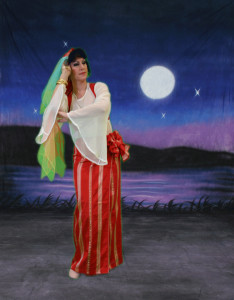
Algerwah ![]()
![]()
(Andalusian Populaire from Algiers)
 In North Africa, the Andalou dance has different styles depending on location and where they came from. For example, in Tunisia the influence comes from Seville, in Algeria the influence comes from Cordoba and Morocco, the influence comes from Grenada and Valencia. These dances are considered renaissance dances.
In North Africa, the Andalou dance has different styles depending on location and where they came from. For example, in Tunisia the influence comes from Seville, in Algeria the influence comes from Cordoba and Morocco, the influence comes from Grenada and Valencia. These dances are considered renaissance dances.
Algerwah is mainly found in Algiers, the capitol of Algeria. As with many North African Andalusian dances, it is a soft dance without heavy accents. Often small scarves are used and the arms and scarves have a floating effect as the hips move and sway from side to side.
This style of dance is originally performed by women called dance “de cour” (hoefesche tanze) (court dances). It was presented when the Sultans and Viziers gathered for meetings and family fests and after classical concerts.
The dancers dressed in rich costumes fixed with gold jewelry and moved with small easy steps with the head gracefully inclined while the arms are designing arabesques. They expressed the melody and harmony by adding and playing with silk scarves in their hands.
This entertainment was the privilege of the bourgeois’ (rich) families. They kept and preserved many old traditions of the society and domestic people.
Music: La Nouba Andalouse is a kind of Malouf music that originally came from Baghdad to Spain in the year 900 a.d. A musician by the name of Ziryab, who came from Baghdad, immigrated to Spain in the 9th century and brought much innovation in the field of music. The Andalou culture was found mainly in the center of large Medinas (Cities) e.g., Fez, Rabat, Tlemcen, Algiers, Constantine, Tunis. The melodies are chants accompanied by an orchestra of tar (tambourines with cymbals), naqqarat (small timbales) and darbuka (drum).
Moorish (Moors) Andalou): When the Arabic folk came to North Africa in the 7th century, they integrated with the Berbers and converted them to Islam. They integrated and became the Moorish population. The Moors conquered the South of Spain and when they integrated with the Spaniards, they became the Andulsian population.
Moors are nothing more than Berber Arabs and the Andulsian are nothing more than the Moorish Spaniards.
The term Moor is interesting as it also was used to refer to the Muslims of Arab descent that lived in Sri Lanka. In the form Moro, it refers to the Muslims who live in the southern Philippines. Moorish art is nothing more than Islamic Art.
References: Mustapha El Oueslati, [email protected], Khadejah El Oueslati, [email protected] , Spektrum Orientalischer Tanz bei Nabila Shams El Din dtd April 2004, Buch # 10.20.068, nabila-shams-el-din.de / Professor Hedi El Cheriffa, Leon, France/Danses du Maghreb d’une rive `a l’autre, Editions Karthala, 1987 / Halima B20644F, 2nd Quartal 2003
